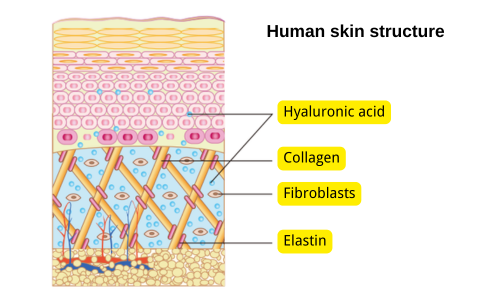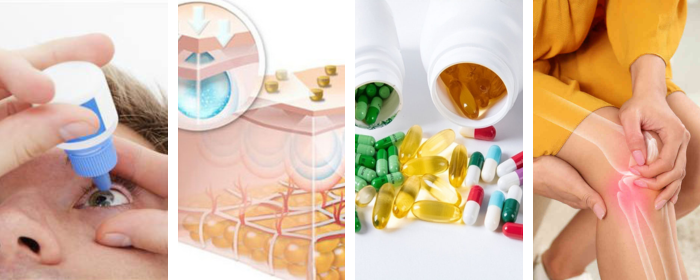Hyaluronic Acid, Sodium Hyaluronate, Hydrolyzed Sodium Hyaluronate: What Are the Differences
Hyaluronic Acid, Sodium Hyaluronate, and Hydrolyzed Sodium Hyaluronate frequently appear as moisturizing ingredients in skincare products. So, what are their respective functions and how do they differ?
They all have moisturizing effects: one is an acid, one is a salt, and one is a hydrolyzed product.
Hyaluronic Acid: The Foundation of Natural Moisturizing Factors
Hyaluronic Acid (HA) is certainly familiar to everyone. Essentially, it is a high molecular weight acidic glycosaminoglycan. In the structure of Hyaluronic Acid, there are numerous hydrogen bonds, which can easily combine with water molecules and absorb up to 1000 times its own weight in water, thus possessing superior water retention properties. HA can increase the skin’s ability to retain water, enhance skin elasticity, plump and fill in fine lines and wrinkles, delaying aging.
Fig 1. The benefits of Hyaluronic Acid
Additionally, Hyaluronic Acid is an important component of human joint lubricant and the vitreous humor in the eyes, playing roles in regulation, permeability, and lubrication. Besides its current use in plastic surgery treatments, it is also widely used clinically in procedures such as intraocular lens implantation, ophthalmic surgeries, and arthritis treatments.
Summary:
- Chemical Structure: HA is a high molecular weight acidic glycosaminoglycan, a type of glycosaminoglycan. Its structure consists of repeating disaccharide units (D-glucuronic acid and N-acetylglucosamine) linked by β-1,4 and β-1,3 glycosidic bonds.
- Molecular Weight: The molecular weight of Hyaluronic Acid ranges widely, from several million Daltons (high molecular weight) to several thousand Daltons (low molecular weight).
- Solubility: It has excellent moisturizing properties in water, but high molecular weight Hyaluronic Acid may form highly viscous solutions during dissolution, making it difficult to disperse evenly.
Sodium Hyaluronate: The Stable Derivative of Hyaluronic Acid with Wide Applications
Like Hyaluronic Acid, Sodium Hyaluronate (SH, Sodium HA) is a component of human skin, present in connective tissues and the dermis. In skincare products, Sodium Hyaluronate is a common form of commercial Hyaluronic Acid, and HA is generally referred to as Sodium HA, serving moisturizing and hydrating functions.
Similar to Hyaluronic Acid, Sodium Hyaluronate can keep the skin soft, smooth, and delicate, and is widely used in the high-end cosmetics industry as well as in the treatment of ocular syndromes.
At the same time, medical Sodium HA has good biocompatibility with the skin, capable of deeply repairing the skin base, hydrating and brightening, fading spots, and reducing acne scars. SH with a purity of 95% is active and plays roles in wound healing and antiviral activity. Therefore, in wound care, it is used to promote the proliferation and differentiation of epidermal cells, accelerate cell regeneration, and promote the healing of damaged areas.
When added to cosmetics, it can provide a barrier protective film for the skin, keeping it smooth, hydrated, delicate, and elastic. It can also be used as a food additive, widely added to dairy products, beverages, alcoholic drinks, and chocolates, but daily intake should not be excessive; the daily intake should be below 200 milligrams.
Summary:
- Chemical Structure: Sodium Hyaluronate is the sodium salt form of HA, formed by neutralizing the carboxyl groups in HA.
- Molecular Weight: Similar to original Hyaluronic Acid, adjustable according to needs.
- Solubility: Solubility and stability are usually better than non-salted Hyaluronic Acid. Its sodium salt form presents lower viscosity upon dissolution in water, making it easier to apply to various products.
Hydrolyzed Sodium Hyaluronate: Advanced Derivative Enhancing Permeability and Bioavailability
Hyaluronic Acid can be broadly divided into high molecular, medium molecular, low molecular, and ultra-low molecular weights, with differences in skin feel, viscosity, and efficacy. Hydrolyzed Sodium Hyaluronate is a form of extremely low molecular weight Hyaluronic Acid, also known as Oligomeric Hyaluronic Acid. Its molecular weight is generally less than 10 KDa, for example, HA-Oligo.
Typically, high molecular Hyaluronic Acid is broken down by enzymes to obtain Hydrolyzed Sodium Hyaluronate with slightly lower molecular weight to improve permeability. Hydrolyzed Sodium Hyaluronate can penetrate through pores and intercellular spaces into the deeper layers of the skin, reaching the dermis to play a foundational repair effect.
Summary:
- Chemical Structure: Hydrolyzed SH is a low molecular weight form obtained by chemically or enzymatically hydrolyzing Sodium Hyaluronate. During hydrolysis, the long chains of Sodium Hyaluronate are cut into shorter polysaccharide or oligosaccharide chains.
- Molecular Weight: Typically less than 10 KDa.
- Solubility: Due to the lower molecular weight, Hydrolyzed Sodium Hyaluronate has higher solubility and lower viscosity in water.
The table 1 below summarizes the differences among Hyaluronic Acid, Sodium Hyaluronate, and Hydrolyzed Sodium Hyaluronate from four dimensions: chemical structure, molecular weight, solubility, and applications.
Table 1. Hyaluronic Acid vs. Sodium Hyaluronate vs. Hydrolyzed Sodium Hyaluronate
Stanford Chemical Company (SCC) is a trusted supplier of Sodium Hyaluronate Powder. We provide customers with high-purity, non-animal, non-GMO Hyaluronic Acid powder, Sodium HA Powder, and HA-Oligo. Enjoy bulk purchase discounts and contract pricing.


